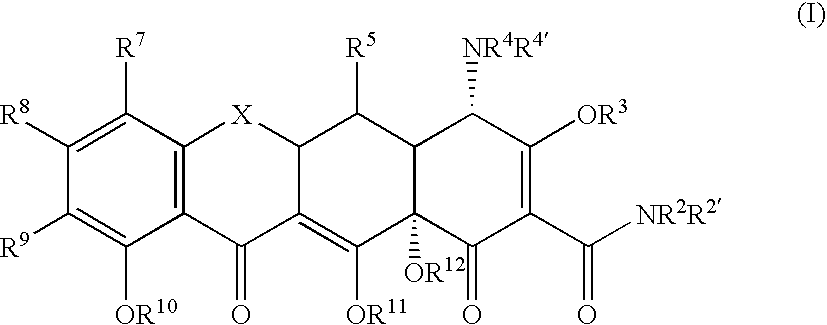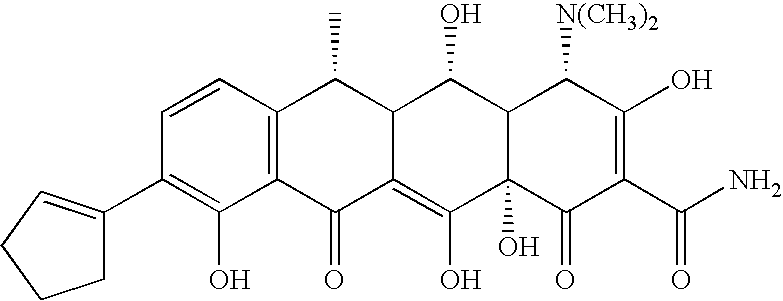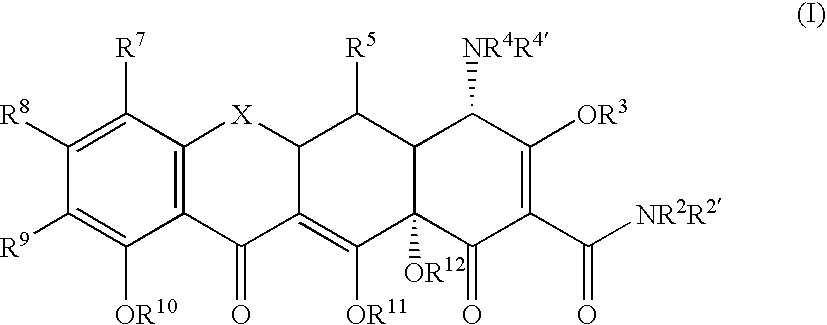Tetracycline compounds for treatment of cryptosporidium parvum related disorders
a cryptosporidium parvum and compound technology, applied in the direction of biocide, antiparasitic agents, drug compositions, etc., can solve the problems of life-threatening, profound, unremitting watery diarrhea and wasting
- Summary
- Abstract
- Description
- Claims
- Application Information
AI Technical Summary
Benefits of technology
Problems solved by technology
Method used
Image
Examples
example 2
Assay for the Ability of Tetracycline Compounds to Control Cryptosporidium parvum Infection in Vitro
[0082]This assay is designed to test the ability of a tetracycline compound to control Cryptosporidium parvum infection in vitro. The results show that tetracycline compounds of the invention can be used to control the growth of C. parvum.
[0083]MDCK cells were grown in 96-well microtiter plastic plates, and were seeded with approximately 5×104 cells per well, using DMEM as the growth / maintenance medium with 10% FCS. Plates were normally grown to confluence 2–3 days after having been seeded with bleached, less than four week-old, C. parvum oocysts. The C. parvum isolate used most often was the human-derived, calf-propagated GCH1 (Tzipori, Clin. Diagn. Lab. Immunol. (1994) 1:450; Tzipori, J. Infect. Dis. (1995) 172:1160). The DMEM medium was also added to the negative control wells. The tetracycline compounds and the oocysts were added to the wells concurrently. The cells were subseque...
example 3
In Vitro Cytotoxicity Assay of Tetracycline Compounds
[0087]The following assay is designed to test the cytotoxicity of the tetracycline compounds of the invention on MDBK cells. Advantageous compounds of the invention are compounds with low cytotoxicity.
[0088]Cytotoxicity of the tetracycline compound is measured by the Cell Titer 96™ Aqueous, a non-radioactive cell proliferation assay, available as a commercial kit. It is a colorimetric method for determining the number of viable cells in proliferation or chemosensitivity assays. The assay is performed by growing MDBK cells in 96-well microliter plates, as in Example 2. Once confluent, the media is aspirated and replaced with 200 μL of media containing the tetracycline compound concentrations which were tested in Example 2. After 48 hour incubation, 40 μL / well of freshly prepared MTS / PMS solution is added. The plate is incubated for two hours at 37° C. and 8% CO2 and then 100 μL of supernatant from each well is transferred to a new ...
example 4
In vivo Assay of Inhibition of Cryptosporidium Parvum Infection
[0089]This study is designed to test the ability of a tetracycline compound to control Cryptosporidium parvum infections in mice. Advantageous compounds of the invention control the Cryptosporidium parvum infection without killing the mice.
[0090]Three 4-week old C.B-17 SCID mice are randomized into six groups of seven mice each. Each animal receives a single I.P. injection of 1 mg of XMG1.2 mAb. Two hours later, mice in five of the six groups are infected with 107 GCH1 oocysts via oral inoculation. Treatment with a tetracycline compounds begins on day 6, post infection, in two divided. doses / day and continues for 10 days.
[0091]At the end of the experiment, all animals are necropsied and sections are taken from the pyloric region of the stomach, mid small intestine, terminal ileum, cecum, proximal colon, and liver / gal bladder for histological analysis to determine the extent of mucosal infection. Each site is assigned a s...
PUM
| Property | Measurement | Unit |
|---|---|---|
| concentration | aaaaa | aaaaa |
| concentration | aaaaa | aaaaa |
| concentration | aaaaa | aaaaa |
Abstract
Description
Claims
Application Information
 Login to View More
Login to View More - R&D
- Intellectual Property
- Life Sciences
- Materials
- Tech Scout
- Unparalleled Data Quality
- Higher Quality Content
- 60% Fewer Hallucinations
Browse by: Latest US Patents, China's latest patents, Technical Efficacy Thesaurus, Application Domain, Technology Topic, Popular Technical Reports.
© 2025 PatSnap. All rights reserved.Legal|Privacy policy|Modern Slavery Act Transparency Statement|Sitemap|About US| Contact US: help@patsnap.com



